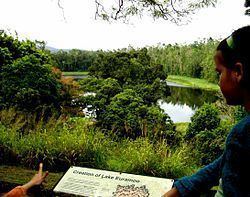Primary outflows no outflow channels Surface elevation 718 m Catchment area 4 ha | Primary inflows Basin countries Australia Mean depth 20 m | |
 | ||
Average depth 20 m (66 ft) (northern basin),16 m (52 ft) (southern basin) | ||
Lake Euramoo (a.k.a. Ngimun & Nuta) is a shallow dumbbell-shaped volcanic crater lake (a maar) in North Queensland, Australia, formed about 10,000 years ago by two massive explosions from groundwater superheating.
Contents
Map of Lake Euramoo, Danbulla QLD 4872, Australia
The crater lake is known to Yidinji, within their oral history and mythology as Ngimun, and known to neighbouring Ngdjon-jii as Nuta; though formally gazetted on the Queensland government's placenames list as 'Lake Euramoo', Euramo being the Dyirbal word for river (yuramu)
The lake (Ngimun) falls within the current Danbulla National Park and State Forest, on the Tertiary uplifted highlands of the Atherton Tableland, within the Wet Tropics of Queensland World Heritage Area, Australia.
Origins
Yidinji and Ngadjon-jii mythology explaining the origin of Ngimun plus two other companion crater lakes, Yidyam (Lake Eacham) and Barany (Lake Barrine), has been described as a plausible and surprisingly accurate oral account of volcanic eruptions or explosions in the area around 10,000 years ago.
It is said that two newly-initiated men broke a taboo and angered the rainbow serpent Yamany, major spirit of the area ... As a result 'the camping-place began to change, the earth under the camp roaring like thunder. The wind started to blow down, as if a cyclone were coming. The camping-place began to twist and crack. While this was happening there was in the sky a red cloud, of a hue never seen before. The people tried to run from side to side but were swallowed by a crack which opened in the ground'....
Vegetation
The vegetation surrounding Lake Euramoo (Ngimun) is a remnant of moist sub montane rainforest, surrounded by previously cleared land that, within the last 50 years, has been planted with endemic Hoop Pine (Araucaria cunninghamii) and exotic conifers, or recolonised by the remnant rainforest species.
Typical moist submontane rainforest species found near Lake Euramoo (Ngimun), within 100 m, include:
Around the margin of Ngimun are identifiable 'zones' of aquatic plants which fluctuate with water depth and the seasons:
